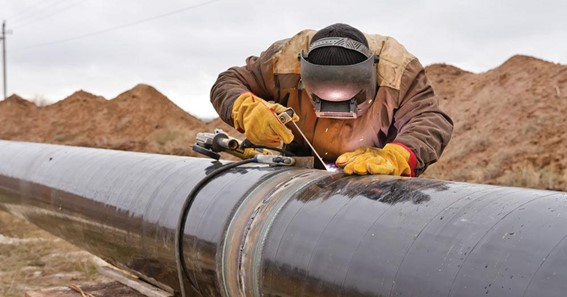Are you curious to know what is arc blow? You have come to the right place as I am going to tell you everything about arc blow in a very simple explanation. Without further discussion let’s begin to know what is arc blow?
In the realm of welding, arc blow is a phenomenon that can present challenges and affect the quality of welds. It refers to the deviation or deflection of the welding arc from its intended path, causing instability and distortion during the welding process. In this blog post, we will delve into the concept of arc blow, explore its causes, impact, and discuss preventive measures to overcome this phenomenon and ensure successful welds.
What Is Arc Blow?
Arc blow occurs when the welding arc is deflected away from its intended direction due to electromagnetic forces created during the welding process. These forces can arise from various factors, including magnetic fields induced by the flow of electrical current, residual magnetism in the base metal, or interactions between the welding current and nearby magnetic objects.
Causes Of Arc Blow
- Magnetic Materials: The presence of magnetic materials near the welding area, such as ferromagnetic metals or magnetic fixtures, can create localized magnetic fields that interfere with the welding arc. These magnetic fields can cause the arc to deviate and result in arc blow.
- Residual Magnetism: Base metals or workpieces may retain residual magnetism from previous manufacturing processes or exposure to magnetic fields. This residual magnetism can influence the welding arc and lead to arc blow.
- Electrical Current Interactions: High welding currents can generate magnetic fields around the welding arc. If these magnetic fields interact with nearby magnetic objects or materials, they can cause arc blow.
Impact Of Arc Blow
Arc blow can have several negative effects on the welding process and the resulting welds:
- Weld Defects: Arc blow can result in uneven or incomplete welds, leading to weld defects such as lack of fusion, inadequate penetration, or uneven bead profiles. These defects compromise the integrity and strength of the weld joint.
- Weld Distortion: The deflection of the welding arc can cause uneven heating and cooling of the base metal, resulting in weld distortion. This can lead to misalignment, warping, or dimensional changes in the welded components.
- Increased Welding Time and Costs: Dealing with arc blow requires additional time and effort to reposition the welding arc, adjust parameters, or employ corrective techniques. This can increase the welding time and associated costs, impacting productivity and efficiency.
Prevention And Mitigation Strategies
- Minimize Magnetic Interference: Avoid welding near or in contact with magnetic objects, fixtures, or materials. If possible, remove or shield any nearby magnetic materials to reduce their influence on the welding arc.
- Demagnetization: Prior to welding, consider demagnetizing the base metal or workpiece to eliminate residual magnetism. This can be achieved through specialized demagnetizing techniques or equipment.
- Proper Grounding: Ensure proper grounding of the welding equipment and workpiece. Adequate grounding helps minimize the effects of electromagnetic forces and reduces the likelihood of arc blow.
- Welding Technique and Parameters: Adjusting welding parameters, such as arc length, welding current, or electrode angle, can help mitigate arc blow. Experiment with different techniques and parameter settings to find the optimal conditions that minimize arc blow.
- Welding Sequence: If feasible, alter the welding sequence to minimize the effects of arc blow. Adjusting the direction of welding passes or alternating the welding direction can help distribute any residual magnetism or magnetic forces more evenly, reducing the impact of arc blow.
Conclusion
Arc blow is a challenging phenomenon in welding that can affect the quality and integrity of welds. Understanding the causes of arc blow and implementing preventive measures is crucial for successful welding operations. By minimizing magnetic interference, addressing residual magnetism, ensuring proper grounding, and adapting welding techniques and parameters, welders can overcome arc blow and achieve high-quality welds with minimal defects and distortion. Remember, continuous practice, experience, and knowledge are essential for effectively managing and mitigating arc blow during the welding process.
To Figure Out Such Kind Things On Shortestt
FAQ
What Is Arc Blow And What Causes It?
Such arc deflection, usually forward or backward of the welding direction, is known as ‘arc blow’. Arc blow tends to occur if the material being welded has residual magnetism at a certain level, particularly when the weld root is being made, and the welding current is direct current (DC positive or negative).
What Is The Arc Blow?
Arc blow occurs in DC arc welding when the arc stream does not follow the shortest path between the electrode and the workpiece and is deflected forward or backward from the direction of travel or, less frequently, to one side.
What Is Arc Blow And How Do You Prevent It?
Arc blow can be controlled or reduced by connecting the work lead to the end of the weld joint, and then welding away from the work lead. Another way of controlling the arc blow is to use two work leads, one on each side of the weld. The best way to eliminate the arc blow is to use alternating current (AC).
What Causes Arc Blow In Mig Welding?
Arc blow can be the result of distortion of the magnetic fields produced by the welding current. The reaction of the magnetic field that surrounds the MIG wire tip and the current flow in the plate to the current return cable can be sufficient to deflect the arc plasma and weld bead.
I Have Covered All The Following Queries And Topics In The Above Article
Causes Of Arc Blow
How Can Arc Blow Be Controlled
How To Prevent Arc Blow
Arc Blow Welding
What Is Magnetic Arc Blow
Effect Of Arc Blow In Welding
How To Prevent Arc Blow In Welding
Arc Blow Causes And Remedies
What Is Arc Blow
What does arc blow look like
What is the arc blow
